Abstract
At very low temperatures, typically ductile materials, especially body-centered cubic (BCC) steels, often exhibit an abrupt transition to brittle fracture, significantly limiting their applicability in cryogenic and low-temperature environments. This challenge arises from the inherent properties of BCC steels, where ductility is drastically reduced, leading to unexpected failures under mechanical stress. Despite the advantages of high-strength BCC steels, including cost-effectiveness and mechanical robustness, their susceptibility to brittle fracture restricts their use in demanding low-temperature applications. To address this limitation, we developed an innovative surface-cracking process to enhance the impact toughness of BCC steels. The introduction of controlled surface cracks redistributes stress and energy dissipation mechanisms, improving the toughness of high-strength BCC steels at cryogenic temperatures. Microscopic observations and finite element analyses reveal that these surface cracks not only dissipate crack formation energy but also alter stress triaxiality at crack tips. This causes the stress state to transition toward a plane stress condition, effectively mitigating stress concentrations typically observed in plane strain states. By reducing localized stress severity and promoting uniform energy distribution, the surface cracks encourage failure mechanisms favoring ductile behavior over brittle fracture.
1. Introduction
In cryogenic applications, selecting materials that maintain mechanical integrity at extremely low temperatures is crucial. Materials with face-centered cubic (FCC) structures, such as austenitic stainless steels, aluminum alloys, nickel alloys, and titanium alloys, are traditionally favored for their superior ductility and resistance to brittle fracture under these conditions [1,2,3,4]. However, the high cost of these materials has driven interest toward more economical alternatives, notably ferritic steels with body-centered cubic (BCC) structures, such as high-strength X80 steel [5,6,7]. Despite their cost-effectiveness and high strength, BCC-structured steels face significant challenges due to their higher ductile-to-brittle transition temperature (DBTT), making them prone to brittle fractures at low temperatures [8,9]. Brittle fractures occur suddenly and without warning, leading to catastrophic failures with severe economic and safety-related consequences. The Charpy impact test is commonly employed to assess a material’s resilience under sudden impact loads, providing insights into its toughness and susceptibility to brittle fracture.
Understanding the transition from plane strain to plane stress in materials under deformation is vital for numerous engineering applications. This transition influences stress concentration, constraint effects, and crack blunting, all of which affect fracture behavior. Recent studies have explored various methods to enhance the low-temperature toughness of BCC steels, considering both conventional and advanced techniques to address their inherent brittleness at low temperatures. Among these, screw press forging has demonstrated significant potential by improving impact toughness at 77 K through grain refinement and enhanced ductility, making it a practical approach for cryogenic applications [10]. Furthermore, advanced screw press forging techniques, such as multi-stage deformation processes, have been developed, not only improving cryogenic toughness but also offering enhanced fatigue resistance [11]. For instance, the addition of rare-earth elements like cerium has been shown to modify inclusions within the steel, transforming large, irregular inclusions into fine, ellipsoidal particles. This modification reduces stress concentrations and inhibits microcrack formation, thereby improving impact toughness at cryogenic temperatures [12]. Another approach involves designing heterogeneous microstructures that promote coordinated deformation mechanisms. A low-carbon micro-alloyed steel with a gradient from ultrafine grains at the surface to coarser grains at the core has demonstrated exceptional impact toughness at 77 K. This performance is attributed to delamination toughening and hetero-deformation-induced hardening, which together enhance both strength and toughness [13]. These advancements in screw press forging, which include controlled deformation processes and microstructural refinements, have been widely adopted to enhance toughness in low-temperature environments, further demonstrating their efficacy for materials like X80 steel. Additionally, heat treatments such as lamellarization near the AC3 temperature have been applied to high-strength, low-alloy steels to increase low-temperature toughness. This process results in a microstructure with increased retained austenite, leading to improved impact toughness without significantly compromising yield strength [14].
Despite these advancements, achieving a balance between strength and toughness in BCC steels at low temperatures remains challenging. Traditional strengthening methods often lead to reduced ductility and increased brittleness. Therefore, novel approaches are continuously being investigated to enhance the low-temperature performance of these materials. In this study, we assess the introduction of controlled surface cracks near notches in BCC steels as a potential method to enhance their toughness at low temperatures. While this method has previously been applied by the authors to different materials [15], its application to cryogenic environments and specific BCC steels necessitates further exploration. The interaction between these surface cracks and the material’s microstructure is analyzed to understand their influence on stress states and fracture behavior. Additionally, the potential applicability of this method to other materials and alloys is considered. This study aims to provide insights that could inform strategies for improving the low-temperature performance of BCC steels, alongside comparisons with existing approaches to evaluate their relative effectiveness.
2. Materials and Methods
The chemical composition of the high-strength BCC steel material used in this study, API X80, was precisely controlled to achieve the desired mechanical properties. The composition includes Fe-0.12C-1.85Mn-0.025P-0.015S-0.45Si-0.1V-0.08Nb-0.06Ti (wt%), ensuring the balance between strength and ductility required for low-temperature applications. In addition, a post-heat treatment was performed at 640 °C for 2 h to further refine the microstructure, enhancing the balance between strength and ductility. This heat treatment was crucial for optimizing the microstructure, ensuring that the material exhibited the necessary combination of mechanical properties for cryogenic applications. The steel was manufactured in cylindrical form with a diameter of 21 inches, a thickness of 38 mm, and a length of 2000 mm, and was heat-treated at 638 °C for 12 h. This material was suitable for producing Charpy impact test specimens, and it was selected due to its known susceptibility to brittle fracture at cryogenic temperatures, making it an ideal candidate for the evaluation of toughness enhancement techniques.
To improve the impact toughness of the material, an innovative surface-cracking process was employed [15]. This method involves the precise introduction of surface cracks to alter the stress distribution at the notch tip, thus mitigating brittle fracture mechanisms. Surface cracks were introduced using wire cut machining (V850G), which ensures high precision in crack placement and dimensions. The surface cracks were oriented perpendicular to the direction of the V-notch in the specimens to effectively redistribute the stress concentration at the notch tip. Specifically, wire machining was performed with a width of 0.3 mm and a depth of 0.1 mm, as illustrated in Figure 1. This configuration was chosen to facilitate the transition from a high triaxial stress state to a more favorable plane stress condition, which can improve energy absorption during impact. To systematically study the effects of surface-cracking, specimens were fabricated with three distinct configurations: standard specimens without surface cracks (0 L), and surface-cracked specimens with 5 lines (5 L) and 10 lines (10 L). This design allowed for a direct comparison of impact toughness between unaltered and modified specimens under identical testing conditions. The varying number of surface cracks enabled the investigation of how crack density influences the redistribution of stress and subsequent improvements in toughness.
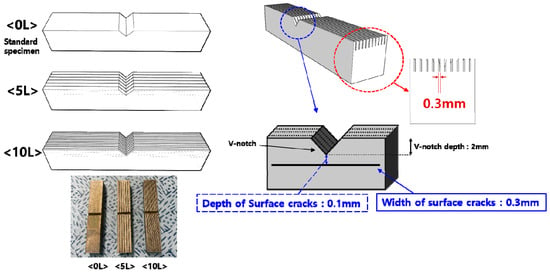
Figure 1.
Schematic design of the Charpy impact test specimen with surface-cracking (5 L, 10 L) used in this study.
The Charpy impact tests were conducted using an automatic ZWIC impact test machine with a maximum energy capacity of 750 J. Testing was performed across a temperature range from −160 °C to 20 °C to simulate conditions encountered in cryogenic applications. The Charpy impact specimens were meticulously prepared following ASTM E23-18 standards [16], ensuring consistency in dimensions and testing conditions. Each specimen measured 10 mm × 10 mm × 55 mm and featured a V-notch with a depth of 2 mm and an angle of 45°, providing a standard geometry for fracture toughness evaluation. To obtain detailed insights into fracture behavior, an instrumented impact pendulum device was utilized, operating at a nominal impact velocity of 5.424 m/s. This setup enabled the precise capture of load–displacement curves during testing, providing critical information about the energy absorption and fracture mechanisms of the specimens. The crack initiation energy (Ei) and crack propagation energy (Ep) could be obtained by the instrumented Charpy impact test. The Ei was calculated as the area under the graph from the start point to the maximum load (Pmax), while the Ep was determined as the area under the graph from the Pmax to the point where it drops to zero. The fracture surfaces of the tested specimens were subsequently analyzed using a field-emission scanning electron microscope (FE-SEM, S-4800, Hitachi, Tokyo, Japan) to observe microstructural features and crack propagation patterns at high magnification. These observations were crucial for correlating the surface-cracking process with the mechanical response of the material, highlighting the effectiveness of the technique in enhancing cryogenic toughness. Through this comprehensive experimental approach, this study aimed to provide a deeper understanding of the role of surface cracks in improving the impact toughness of BCC steels and their potential application in cryogenic environments.
To further explore the relationship between surface cracks and stress triaxiality, finite element (FE) analysis was performed using Abaqus 2018 (Explicit solver) software based on the Charpy V-notch (CVN) impact test results for high-strength steel in this study. The FE model was designed to replicate the experimental setup and consisted of three key components: the striker, anvil, and specimen. The striker and anvil were modeled as rigid bodies, while the specimen was represented as a quarter-symmetric model composed of deformable C3D8R elements (8-node linear brick elements with reduced integration and hourglass control). This approach ensured computational efficiency and an accurate representation of the material’s behavior under impact loading. The notch in the specimen was modeled with a precise size of 0.1 mm in the x-direction using a fine mesh size of 0.15 mm near the notch. The mesh size was progressively increased as the distance from the notch increased, ensuring a balance between computational cost and accuracy. The striker’s weight was set to 12.7465 kg, corresponding to one-fourth of the full equipment weight (50.986 kg), to account for the quarter-symmetric model. The striker’s velocity was fixed at 5.42 m/s, matching the experimental impact conditions. To accurately simulate the high-speed deformation and failure of X80 steel at room temperature, the Johnson–Cook (J-C) constitutive equation and failure model were employed.
3. Results
Figure 2 illustrates the microstructure of X80 steel as observed using optical microscopy (OM) (Figure 2a,b) and scanning electron microscopy (SEM) (Figure 2c,d). The microstructure primarily consists of polygonal ferrite (PF), acicular ferrite (AF), granular bainite (GB), bainitic ferrite (BF), and a small fraction of martensite–austenite (M-A) constituents. The predominant phase is acicular ferrite (AF), characterized by randomly oriented needle-like structures. This morphology significantly enhances crack resistance while providing high strength and excellent impact toughness. Polygonal ferrite (PF), with its very low dislocation density within the grains, contributes to the material’s high ductility. Granular bainite (GB) exhibits an irregular granular morphology and contains embedded M-A constituents. Bainitic ferrite (BF), which forms under rapid cooling conditions, features a higher dislocation density within its microstructure, contributing to its strength and toughness.
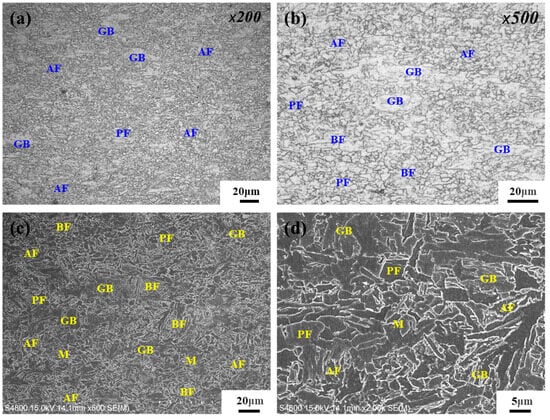
Figure 2.
Microstructure of X80 steels obtained from OM (a,b) and SEM (c,d) at different magnifications.
The relationship between absorbed energy and temperature for high-strength BCC materials with surface cracks is depicted in Figure 3a. As the temperature decreases, the absorbed energy shows a consistent decline, reflecting the material’s reduced ability to dissipate impact energy at lower temperatures. For the 0 L specimen, which lacks surface cracks, a sharp ductile–brittle transition (DBT) is observed around −81 °C. This behavior is typical for materials with a BCC structure, where the transition from ductile to brittle failure occurs abruptly with decreasing temperature. In contrast, specimens with surface cracks (5 L and 10 L) exhibit a more gradual DBT, and the transition temperature shifts to significantly lower values as the number of surface cracks increases. Notably, the 10 L specimen demonstrates the highest absorbed energy across the entire temperature range, particularly at cryogenic temperatures. This improvement indicates that the introduction of surface cracks reduces the triaxial stress concentration near the V-notch, thereby promoting ductile fracture mechanisms even under extreme conditions. The observed trend aligns with findings from previous studies using Charpy impact tests, where sub-sized specimens displayed a lower DBTT compared to full-sized specimens due to reduced constraint and thickness effects. Similarly, the presence of surface cracks in this study mimics the effect of reducing specimen thickness, thereby mitigating constraint effects and enhancing the material’s ability to absorb energy. This highlights the critical role of surface cracks in improving the impact toughness of BCC steels, particularly in very-low-temperature environments. Figure 3b,c provide critical insights into the mechanical behavior of 0 L, 5 L, and 10 L specimens during instrumented Charpy impact tests. The crack initiation energy (Ei) and the crack propagation energy (Ep) are calculated by determining the areas below the load–displacement curves based on the maximum load (Pmax). At room temperature (20 °C), all three specimens exhibit similar load–displacement curves, indicating comparable impact energy absorption and dominant ductile fracture mechanisms. This similarity suggests that the presence or absence of surface cracks has little effect on the fracture behavior of the material under ambient conditions. However, at −140 °C, significant differences emerge among the specimens. The 0 L and 5 L specimens exhibit a sharp and sudden drop in load immediately following the peak load (Pmax), indicative of brittle fracture with minimal plastic deformation. In contrast, the 10 L specimen demonstrates a more gradual load reduction after reaching Pmax, reflecting enhanced toughness and the ability to sustain greater plastic deformation even under extreme low-temperature conditions. This behavior highlights the effectiveness of the surface-cracking technique in mitigating brittle fracture and improving cryogenic toughness.
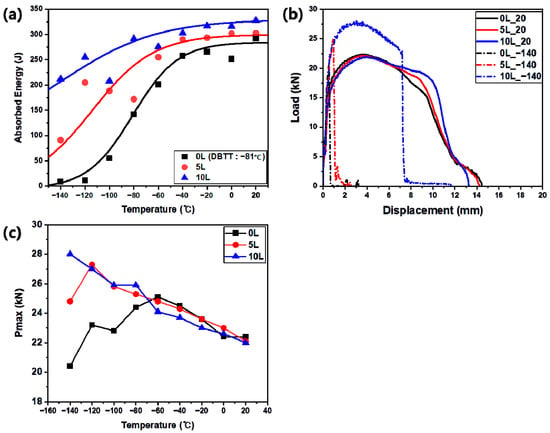
Figure 3.
The absorbed energy as a function of the test temperature curves, load–displacement graphs, and Pmax obtained from the instrumented Charpy impact test from room temperature to very low temperatures: (a) absorbed energy, (b) load–displacement graphs, and (c) maximum load (Pmax) from the Charpy impact test.
Figure 3c illustrates the temperature dependence of Pmax, providing further evidence of the varying fracture behavior among the specimens. For the 0 L specimen, Pmax initially increases as the test temperature decreases, owing to the strengthening effect typically observed at lower temperatures. However, Pmax begins to decline sharply near the DBTT of approximately −80 °C, signaling the onset of brittle fracture. A similar trend is observed for the 5 L specimen, although its Pmax values remain marginally higher than those of the 0 L specimen at lower temperatures. This indicates that the presence of surface cracks in the 5 L specimen provides some degree of stress redistribution, delaying the onset of brittle failure. In contrast, the 10 L specimen exhibits markedly different behavior. Its Pmax values gradually increase with decreasing temperature and remain stable even at −140 °C. This stability reflects the specimen’s enhanced ability to resist brittle fracture, attributed to the higher density of surface cracks. These cracks act as stress redistributors, reducing triaxial stress concentrations at the notch tip and promoting a more favorable plane stress state [17,18,19]. This mechanism enables the material to sustain higher loads and exhibit improved toughness, even under cryogenic conditions. Pmax, as obtained from instrumented Charpy impact tests, serves as a comprehensive indicator of material strength, stress levels, and confinement effects. As temperature decreases, Pmax typically increases due to heightened material strength and brittleness. However, below the DBTT, lower Pmax values are observed in the 0 L and 5 L specimens, indicating a loss of plastic deformation capability, accelerated crack propagation, and reduced fracture toughness.
Conversely, the gradual rise in Pmax observed for the 10 L specimen across the temperature range underscores the benefits of surface cracking in alleviating stress concentrations and promoting ductile fracture mechanisms. The introduction of surface cracks in the 5 L and 10 L specimens, particularly the higher crack density in the 10 L specimen, plays a pivotal role in enhancing cryogenic performance. These cracks act as local stress concentrators, allowing for better stress redistribution and improved resistance to brittle failure. The divergence in behavior between the 0 L and surface-cracked specimens at lower temperatures demonstrates the effectiveness of the surface-cracking technique in tailoring the fracture properties of BCC steels for cryogenic applications.
In Figure 4, the ratio of crack initiation energy (Ei) to crack propagation energy (Ep) is illustrated, derived from calculating the areas beneath load–displacement curves based on the Pmax. As the temperature decreases to −80 °C, all specimens exhibit Ei values ranging between 83 and 123 J, accompanied by a gradual decline in Ep. However, as temperatures drop further below −80 °C, significant differences emerge among the specimens. The 0 L specimen shows a substantial reduction in Ei, reaching approximately 29 J, which reflects a dramatic loss in its ability to absorb energy for crack initiation. This drastic decline highlights the brittle nature of the material in extreme cryogenic conditions.
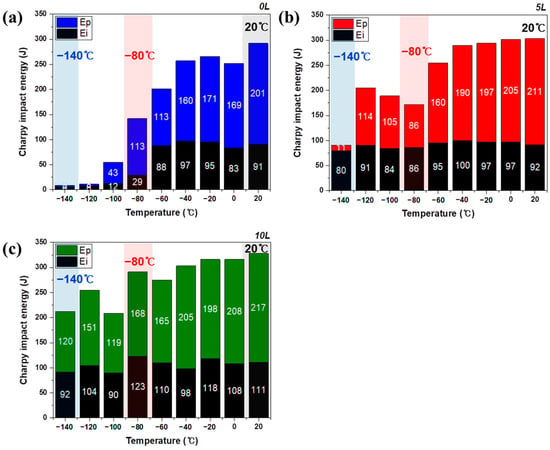
Figure 4.
The ratio of crack initiation energy (Ei) to crack propagation energy (Ep) of high-strength steels from room temperature to very low temperatures: (a) the standard specimen (0 L); (b) the surface-cracked specimen with 5 lines (5 L) and (c) 10 lines (10 L).
In contrast, the 5 L and 10 L specimens demonstrate significantly higher Ei values, approximately 90 J, indicating a considerable improvement in energy absorption capacity. At −140 °C, the 5 L specimen exhibits a noticeable decrease in overall impact energy, primarily due to a sharp decline in Ep to around 11 J, despite maintaining a relatively high Ei value of approximately 80 J. This suggests that while the 5 L specimen retains its ability to initiate cracks, its crack propagation resistance is severely compromised under these conditions. On the other hand, the 10 L specimen maintains both high Ei and Ep values even at −140 °C, underscoring its superior ability to resist crack growth and maintain high impact toughness at extremely low temperatures.
This observation demonstrates the effectiveness of the surface-cracking process, particularly with a higher number of surface cracks, in preserving impact toughness across a range of temperatures. Despite the overall decrease in Ep with declining temperature, the surface-cracking process consistently preserves Ei, ensuring sufficient toughness even under severe cryogenic conditions. The correlation between the number of surface cracks and the effectiveness of impact toughness enhancement further emphasizes the role of surface cracks in altering fracture behavior. The surface-cracking process fundamentally modifies the stress state near the crack tip, influencing crack propagation and energy absorption mechanisms. From the perspective of triaxial stress, this improvement can be explained by transitions in the stress state, reductions in stress concentration, and alterations in confinement effects. Surface cracks locally disrupt the triaxial stress state around the crack tip, transitioning it toward a plane stress-like state. This localized relief of triaxial stress leads to a significant reduction in stress concentrations, particularly in the thickness direction. In thin structures under plane stress conditions, stress concentrations are mitigated by the absence of confinement in the thickness direction, promoting energy dissipation [20,21].
In contrast, in thicker structures under plane strain conditions, higher triaxial stress states and greater stress concentrations at the crack tip exacerbate the likelihood of brittle fracture. In plane strain conditions, the surrounding material constrains deformation near the crack tip, enhancing the likelihood of brittle fracture—a failure mode characterized by minimal deformation and abrupt catastrophic failure [22,23,24]. Surface cracks weaken this confinement effect by introducing alternative deformation pathways. This reduced confinement allows for greater plastic deformation near the crack tip, facilitating ductile deformation mechanisms. Ductile deformation, characterized by significant plastic strain before failure, increases resistance to crack growth and enhances overall toughness. Overall, the presence of surface cracks significantly influences the triaxial stress state at the crack tip, leading to a more relaxed stress environment and reduced confinement effects. These modifications contribute to enhanced ductility and crack resistance, effectively mitigating the adverse effects of brittle fracture. The observations in Figure 4 highlight the critical role of surface cracks in improving the cryogenic performance of BCC steels, offering a practical approach to enhancing material toughness in extreme environments.
In Figure 5, the fracture surfaces of standard specimens (0 L) and surface-cracked specimens (5 L, 10 L) are analyzed at three different temperatures: 20 °C, −80 °C, and −140 °C. At 20 °C, all specimens exhibit significant plastic deformation, as evidenced by the presence of a well-defined and extended stretch zone width (SZW, red arrows) (Figure 5a–c). The SZW represents the region on the fracture surface where cracks initiate and grow through plastic deformation. A longer SZW is generally associated with higher absorbed energy, reflecting the material’s capacity for plastic deformation during fracture. In specimens with surface cracks (white arrows), the expanded area near the notch root contributes to SZW, accompanied by notch blunting. This phenomenon, linked to ductile fracture, indicates stable crack growth with significant energy absorption. Previous studies have shown that an expanded stretch zone correlates with stable ductile fracture behavior, resulting in improved impact toughness and higher energy absorption [25]. At −80 °C, the SZW in the 0 L specimen becomes significantly shorter compared to that observed at room temperature (Figure 5d). This reduction suggests diminished crack initiation energy (Ei) and overall impact energy (Figure 4a). However, surface-cracked specimens (5 L and 10 L) maintain a relatively long SZW even at this lower temperature, demonstrating sustained energy absorption capacity and excellent impact toughness. In addition to SZW, another key feature observed in Figure 5 is the formation of dimples on the fracture surface. The proportion of dimples, indicative of ductile fracture, increases with the number of surface cracks, as seen in the 5 L and 10 L specimens. This observation suggests that the presence of surface cracks promotes energy dissipation through plastic deformation mechanisms. Furthermore, specimens with a higher density of surface cracks (e.g., 10 L) exhibit more extensive plastic deformation, as evidenced by their rougher and more elongated surface cracks. These features provide additional confirmation of the ductile-to-brittle transition behavior in the specimens. The Charpy impact energy and instrumented data presented in Figure 3 and Figure 4 corroborate this observation. As the number of surface cracks increases from 0 to 10 lines, the SZW progressively elongates, highlighting the role of surface cracks in providing additional pathways for crack propagation. These multiple crack pathways enhance stress redistribution and promote energy dissipation, thereby increasing the absorbed energy. In the central regions of the fractured specimens, the 0 L and 5 L specimens exhibit a mixture of dimple and quasi-brittle cleavage fracture modes, whereas the 10 L specimen displays a predominantly ductile fracture mode, further emphasizing the effectiveness of surface cracks in enhancing ductility and toughness. At −140 °C, fracture behavior becomes even more distinct among the specimens. The 0 L specimen undergoes immediate brittle fracture, with the complete absence of a stretch zone, reflecting a dramatic loss of energy absorption capacity. In the central region of the fractured specimen, large cleavage fracture packets (sky-blue arrows) are observed in the 0 L specimen, confirming the occurrence of brittle fracture. In contrast, both the 5 L and 10 L specimens exhibit a visible SZW, even under these extreme cryogenic conditions. While the 5 L specimen shows a mixed brittle and ductile fracture mode, the 10 L specimen demonstrates a more ductile-dominated fracture, evidenced by its longer SZW. This indicates that the higher density of surface cracks in the 10 L specimen contributes significantly to preserving Ei and enhancing the material’s resistance to brittle failure. The persistent and elongated SZW in the 10 L specimen underscores the critical role of surface cracking in improving toughness, even at temperatures where brittle fracture typically dominates. In summary, the strategic introduction of surface cracks is pivotal in altering stress distribution and crack propagation behavior. By facilitating a longer SZW and promoting ductile fracture mechanisms, surface cracks effectively preserve Ei and enhance impact toughness across a range of temperatures. This improvement is particularly pronounced at extremely low temperatures, where the detrimental effects of brittle fracture are mitigated, showcasing the potential of surface-cracking techniques for improving the cryogenic performance of BCC steels.
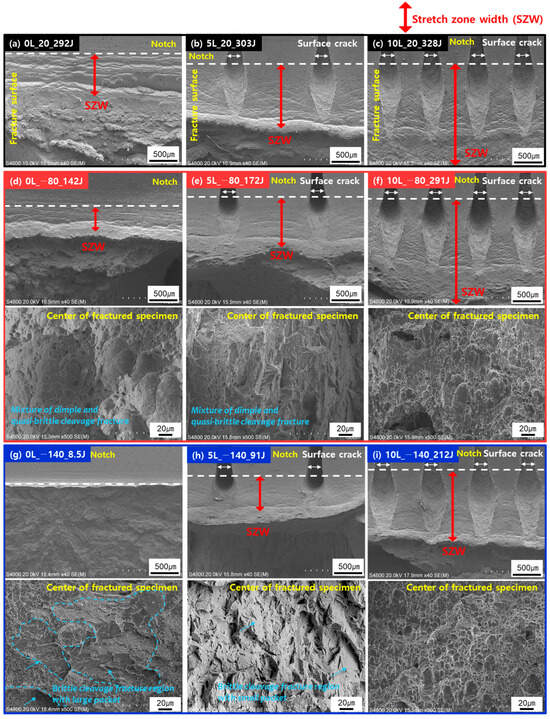
Figure 5.
The fracture surface of X80 steels with the surface-cracking process applied around the notch and center of the impact-fractured specimen at various temperatures: (a–c) 20 °C, (d–f) −80 °C, and (g–i) −140 °C.
Figure 6 provides a schematic representation of the 1/4 finite element (FE) model used for the Charpy V-notch (CVN) impact testing of high-strength steel at room temperature. The schematic includes both a front view (Figure 6a) and a side view (Figure 6b) of the 5 L configuration. As illustrated in Figure 5, there is a clear correlation between the number of surface cracks and the ductility of the specimen. Specimens with a greater number of surface cracks exhibit higher ductility, which can be attributed to the influence of surface cracks on the material’s stress state, particularly stress triaxiality. Stress triaxiality, defined as the ratio of hydrostatic pressure to equivalent stress, is a critical parameter for understanding plastic deformation and fracture behavior in materials [26,27,28,29,30]. A reduction in stress triaxiality generally promotes shear deformation, a form of plastic deformation that enhances ductility and toughness. This occurs as the material absorbs more energy during deformation before failure. The introduction of surface cracks modifies the stress state near the crack tip, reducing triaxial stress and facilitating ductile deformation. This modification ultimately leads to improved energy absorption and greater resistance to fracture. The Johnson–Cook (J-C) model is particularly well suited for describing the strain-rate-dependent behavior and thermal effects of materials under dynamic loading conditions. It enables the precise modeling of material behavior during high-speed impacts, capturing the complex interactions among stress, strain, and temperature during deformation and fracture. The simulation results provide valuable insights into the role of surface cracks in altering stress states and promoting ductile fracture mechanisms. By reducing triaxial stress concentrations and enabling localized shear deformation, surface cracks significantly enhance the material’s toughness and resistance to brittle failure. These findings further validate the hypothesis that surface-cracking techniques are a promising strategy for improving the mechanical performance of high-strength steels in demanding applications.
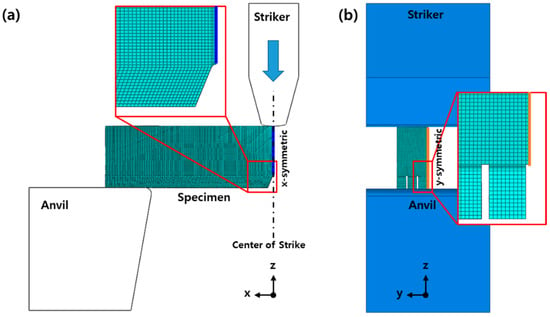
Figure 6.
Schematic diagram (5 L) of the 1/4 FE model for CVN impact testing at room temperature of high-strength steel in this study: (a) front view and (b) side view.
Figure 7 presents the specimen geometry, equivalent stress distribution, and triaxiality distribution across the cross-section at various displacement values, as obtained from the finite element analysis. In the 0 L specimen, where triaxiality exceeds 1.0 during deformation (gray area), cracks initiate at a displacement of 8 mm and propagate with further displacement, as illustrated in Figure 7a. The crack front is the boundary along the length of the crack, defining where the crack exists. This behavior highlights the influence of high triaxial stress on crack initiation and propagation, particularly in specimens without surface cracks. In contrast, the 5 L and 10 L specimens exhibit significantly lower maximum triaxiality values, remaining below 1.0 throughout the deformation process, as shown in Figure 7b,c. Notably, no cracks are observed in these specimens, suggesting that the presence of surface cracks effectively mitigates triaxial stress and delays crack initiation. Among the surface-cracked specimens, the 10 L specimen displays the lowest maximum triaxiality compared to the 5 L specimen, emphasizing a correlation between the number of surface cracks and reduced triaxiality within the material. This finding suggests that increasing the number of surface cracks contributes to more uniform stress redistribution, thereby reducing the likelihood of localized stress concentration. When the triaxiality distribution across the cross-section with increasing displacement is examined, it is observed that in the 0 L specimen, regions of high triaxiality are concentrated at the crack front, which aligns with the onset and growth of cracks. In contrast, for the 5 L and 10 L specimens, regions with high triaxiality shift closer to the neutral axis, and the size of these regions tends to decrease with increasing displacement. This indicates that the introduction of surface cracks alters the stress distribution, reducing the extent of critical stress zones and promoting a more stable deformation process. To further understand the overall triaxiality trend in the critical crack region, the average triaxiality of the central cross-section was calculated for displacements ranging from 4 mm to 20 mm, as shown in Figure 7d. The results reveal a gradual increase in triaxiality with displacement across all specimens, peaking between 18 mm and 20 mm. However, specimens with more surface cracks consistently exhibit lower average triaxiality throughout the deformation process. This reduction in average triaxiality is particularly evident in the 10 L specimen, which demonstrates the most effective stress redistribution among the tested configurations.
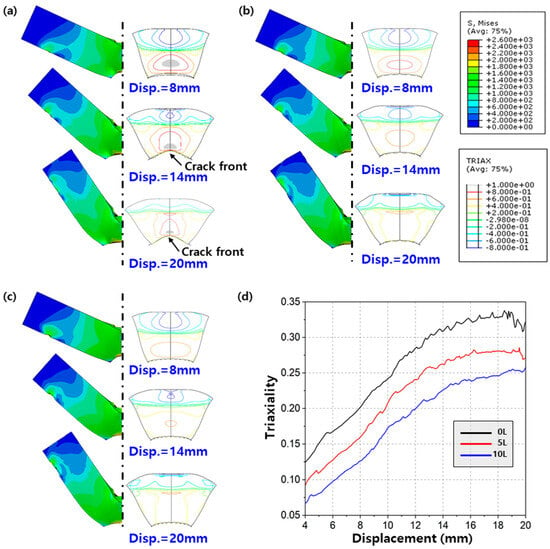
Figure 7.
Finite element analysis results for deformation (top view) and triaxiality distribution (cross-section view) according to changing displacement (8 mm, 14 mm, 20 mm) for the Charpy impact specimens caused by surface cracks: (a) 0 L, (b) 5 L, and (c) 10 L sample and (d) average triaxiality.
In summary, the analysis underscores the critical role of surface cracks in reducing triaxial stress and enhancing the deformation stability of high-strength steel specimens. By lowering the maximum and average triaxiality, surface cracks delay the onset of crack initiation, mitigate stress concentrations, and promote more uniform energy dissipation during deformation. These findings further validate the effectiveness of surface-cracking techniques in improving the mechanical performance and fracture resistance of BCC steels under dynamic loading conditions [31].
4. Conclusions
To improve impact toughness under extremely low-temperature conditions, Charpy impact specimens were subjected to a surface-cracking process, and their temperature-dependent impact energy was thoroughly analyzed. Experimental evaluations, combined with microstructural and finite element analyses, revealed the mechanisms by which surface cracks influence triaxiality and confinement effects near the notch tip. The findings demonstrate that introducing controlled surface cracks effectively enhances impact toughness, particularly in cryogenic environments where brittle fracture dominates. Surface cracks redistribute stress and reduce triaxiality near the crack tip, creating a more relaxed stress state and mitigating localized stress concentrations. This stress redistribution shifts the fracture behavior toward ductile mechanisms, enabling the material to absorb more energy during deformation and improving its resistance to crack initiation and propagation under extreme conditions. These findings highlight the potential of surface cracking as a tailored strategy to address brittle fracture challenges in BCC steels, offering a practical approach to enhancing the mechanical performance of materials in extreme environments.
Author Contributions
Conceptualization, M.P. and B.J.K.; methodology, S.N.; software, C.L.; formal analysis, B.K.; investigation, G.H.L.; data curation, C.L. and J.B.J.; writing—original draft preparation, M.P. and B.J.K.; writing—review and editing, M.P. and C.L.; supervision, B.J.K. and C.L. All authors have read and agreed to the published version of the manuscript.
Funding
This study was supported by the R&D Program of the Materials/Parts Technology Development Program (RS-2024-00444679, Development of test evaluation, standardization and filed engineering technology for high-pressure hydrogen pipe).
Data Availability Statement
Data are contained within the article.
Conflicts of Interest
The authors declare no conflicts of interest.
References
- Zheng, C.; Yu, W. Effect of low-temperature on mechanical behavior for an AISI 304 austenitic stainless steel. Mater. Sci. Eng. A 2018, 710, 359–365. [Google Scholar] [CrossRef]
- Kim, J.; Kim, H.J.; Morris, J. The role of the constituent phases in determining the low temperature toughness of 5.5 Ni Cryogenic steel. Metall. Trans. A 1984, 15, 2213–2219. [Google Scholar] [CrossRef]
- Srivatsan, T.S.; Sriram, S.; Veeraraghavan, D.; Vasudevan, V.K. Microstructure, tensile deformation and fracture behaviour of aluminium alloy 7055. J. Mater. Sci. 1997, 32, 2883–2894. [Google Scholar] [CrossRef]
- Akmoulin, I.A.; Niinomi, M.; Kobayashi, T. Dynamic fracture behavior of Ti-6Al-4V alloy with various stabilities of β phase. Metall. Trans. A 2016, 25, 1655–1666. [Google Scholar] [CrossRef]
- Qiao, X.; Han, L.; Zhang, W.; Gu, J. Thermal stability of retained austenite in high-carbon steels during cryogenic and temperaing treatments. ISIJ Int. 2016, 56, 140–147. [Google Scholar] [CrossRef]
- Prieto, G.; Ipiña, J.P.; Tuckart, W.R. Cryogenic treatments on AISI 420 stainless steel: Microstructure and mechanical properties. Mater. Sci. Eng. A 2014, 605, 236–243. [Google Scholar] [CrossRef]
- Hong, S.; Shin, S.Y.; Lee, S.; Kim, N.J. Effects of specimen thickness and notch shape on fracture modes in the drop weight tear test of API X80 and X80 linepipe steels. Metall. Trans. A 2011, 42, 2619–2632. [Google Scholar] [CrossRef]
- Mitchell, E.B.; Lucon, E.; Collins, L.E.; Clarke, A.J.; Clarke, K.D. Microstructure and thickness effects on impact behavior and separation formation in X70 pipeline steel. JOM 2021, 73, 1966–1977. [Google Scholar] [CrossRef]
- Zhao, J.; Hu, W.; Wang, X.; Kang, J.; Yuan, G.; Di, H.; Misra, R. Effect of microstructure on the crack propagation behavior of microalloyed 560 MPa (X80) strip during ultra-fast cooling. Mater. Sci. Eng. A 2016, 666, 214–224. [Google Scholar] [CrossRef]
- Huang, J.; Xu, J.; Wu, X.; Wang, C.; Jin, C.; Ji, X.; Han, T. Effects of different forging ratios on microstructure, mechanical properties and friction and wear behavior of Q355D steel. Prof. Met. Phys. Chem. Surf. 2024, 60, 270–281. [Google Scholar] [CrossRef]
- Jo, A.R.; Jeong, M.S.; Lee, S.K.; Moon, Y.H.; Hwang, S.K. Multi-stage cold forging process for manufacturing a high-strength one-body input shaft. Materials 2021, 14, 532. [Google Scholar] [CrossRef]
- Yang, G.-K.; Zhuang, C.-L.; Li, Y.-Z.; Hu, C.; Li, S.-B. Enhancement of low-temperature toughness of Fe-Mn-C-Al alloy by rare earth Ce-modified inclusions. J. Iron Steel Res. Int. 2024, 31, 157–173. [Google Scholar] [CrossRef]
- Xu, X.; Kumar, P.; Cao, R.; Ye, Q.; Chu, Y.; Tian, Y.; Li, Y.; Ritchie, R.O. Exceptional cryogenic-to-ambient impact toughness of a low carbon micro-alloyed steel with a multi-heterogeneous structure. Act. Mater. 2024, 274, 120019. [Google Scholar] [CrossRef]
- Frichtl, M.; Anwar, Y.; Strifas, A.; Ankem, S. Improving the low-temperature toughness of a high-strength, low-alloy steel with a lamellarization heat treatment. Met. Mater. Int. 2023, 29, 879–891. [Google Scholar] [CrossRef]
- Kim, K.; Park, M.; Jang, J.; Kim, H.C.; Moon, H.-S.; Kim, D.-H.; Jeon, J.B.; Kwon, S.-H.; Kim, H.; Kim, B.J. Improvement of strength and impact toughness for cold-worked austenitic stainless steels using a surface-cracking technique. Metals 2018, 8, 932–946. [Google Scholar] [CrossRef]
- ASTM E23-18; Standard Test Methods for Notched Bar Impact Testing of Metallic Materials. ASTM International Publish: West Conshohocken, PA, USA, 2018.
- Rzepa, S.; Bucki, T.; Konopík, P.; Džugan, J.; Rund, M.; Procházka, R. Influence of specimen dimensions on ductile-to-brittle transition temperature in Charpy impact test. IOP Conf. Ser. Mater. Sci. Eng. 2017, 179, 012063. [Google Scholar] [CrossRef]
- Kim, B.J.; Mitsui, H.; Kasada, R.; Kimura, A. Evaluation of impact properties of weld joint of reactor pressure vessel steels with the use of miniaturized specimens. J. Nucl. Sci. Technol. 2012, 49, 618–631. [Google Scholar] [CrossRef]
- Kim, W.; Paivi, K.-R.; Pasi, S. Sub-sized CVN specimen conversion methodology. Proc. Struct. Integr. 2016, 2, 3735–3742. [Google Scholar]
- Rahmatabadi, D.; Hashemi, R.; Mohammadi, B.; Shojaee, T. Experimental evaluation of the plane stress fracture toughness for ultra-fine grained aluminum specimens prepared by accumulative roll bonding process. Mater. Sci. Eng. A 2017, 708, 301–310. [Google Scholar] [CrossRef]
- Kumar, N.; Owolabi, G.M.; Jayaganthan, R.; Ajide, O.O. Plane stress fracture toughness of cryorolled 6082 Al alloy. Theor. Appl. Fract. Mech. 2018, 95, 24–41. [Google Scholar] [CrossRef]
- Rice, J.R.; Sorensen, E.P. Continuing crack-tip deformation and fracture for plane-strain crack growth in elastic-plastic solids. J. Mech. Phys. Solids 1978, 26, 163–186. [Google Scholar] [CrossRef]
- McMeeking, R.M. Blunting of a plane strain crack tip into a shape with vertices. J. Eng. Mater. Technol. 1977, 99, 290–297. [Google Scholar] [CrossRef]
- Lee, Y.; Prakash, V. Dynamic brittle fracture of high strength structural steels under conditions of plane strain. Int. J. Solid. Struct. 1999, 36, 3293–3337. [Google Scholar] [CrossRef]
- Tami, T.; Nagumo, M. Fracture process of a low carbon low alloy steel relevant to charpy toughness at ductile-brittle fracture transition region. Metall. Trans. A 1995, 26, 391–399. [Google Scholar]
- Barsoum, I.; Faleskog, J. Rupture mechanisms in combined tension and shear-experiments. Int. J. Solid. Struct. 2007, 44, 1768–1786. [Google Scholar] [CrossRef]
- Bai, Y.; Wierzbicki, T. A new model of metal plasticity and fracture with pressure and lode dependence. Int. J. Plast. 2008, 24, 1071–1096. [Google Scholar] [CrossRef]
- Barsoum, I.; Faleskog, J. Rupture mechanisms in combined tension and shear-Micromechanics. Int. J. Solid. Struct. 2007, 44, 5481–5498. [Google Scholar] [CrossRef]
- Keshavarz, A.; Ghajar, R.; Mirone, G. A new experimental failure model based on triaxiality factor and lode angle for X-100 pipeline steel. Int. J. Mech. Sci. 2014, 80, 175–182. [Google Scholar] [CrossRef]
- Dorogoy, A.; Rittel, D.; Godinger, A. Modification of the shear-compression specimen for large strain testing. Exp. Mech. 2015, 55, 1627–1639. [Google Scholar] [CrossRef]
- Cao, Y.; Zhen, Y.; Song., M.; Yi., H.; Li., F.; Li., X. Determination of Johnson-Cook parameters and evaluation of Charpy impat test performance for X80 pipeline steel. Int. J. Mech. Sci. 2020, 179, 105627. [Google Scholar] [CrossRef]
Disclaimer/Publisher’s Note: The statements, opinions and data contained in all publications are solely those of the individual author(s) and contributor(s) and not of MDPI and/or the editor(s). MDPI and/or the editor(s) disclaim responsibility for any injury to people or property resulting from any ideas, methods, instructions or products referred to in the content. |
© 2025 by the authors. Licensee MDPI, Basel, Switzerland. This article is an open access article distributed under the terms and conditions of the Creative Commons Attribution (CC BY) license (https://creativecommons.org/licenses/by/4.0/).